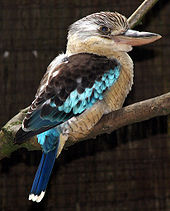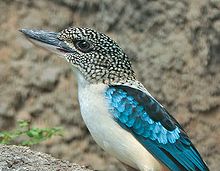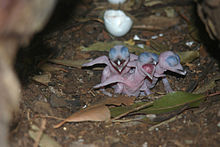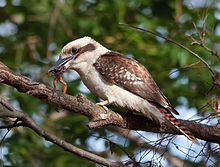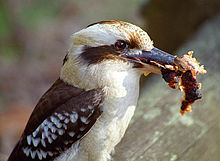
Kookaburra
About this schools Wikipedia selection
SOS believes education gives a better chance in life to children in the developing world too. To compare sponsorship charities this is the best sponsorship link.
| Kookaburra | |
|---|---|
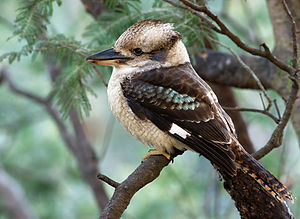 |
|
| Laughing Kookaburra in Tasmania, Australia | |
| Scientific classification | |
| Kingdom: | Animalia |
| Phylum: | Chordata |
| Class: | Aves |
| Order: | Coraciiformes |
| Family: | Halcyonidae |
| Genus: | Dacelo Leach, 1815 |
Kookaburras (genus Dacelo) are terrestrial tree kingfishers native to Australia and New Guinea. They are large to very large, with a total length of 28–42 cm (11–17 in). The name is a loanword from Wiradjuri guuguubarra, and is onomatopoeic of its call. The single member of the genus Clytoceyx, though commonly referred to as the Shovel-billed Kookaburra, is not treated in this article.
Kookaburras are best known for their unmistakable call, which sounds uncannily like loud, echoing human laughter – good-natured, but rather hysterical, merriment in the case of the renowned Laughing Kookaburra (Dacelo novaeguineae); and maniacal cackling in the case of the slightly smaller Blue-winged Kookaburra (D. leachii). They are generally not closely associated with water, and can be found in habitats ranging from humid forest to arid savanna, but also in suburban and residential areas with tall trees or near running water and where food can be searched for easily.
Classification and species
There are four known species of kookaburra found in Australia, New Guinea, and the Aru Islands.
All kookaburras are sexually dimorphic, but this is only obvious in the Blue-winged and the Rufous-bellied, where males have noticeably blue tails and females have rufous (reddish-brown) tails.
- Rufous-bellied Kookaburra (Dacelo gaudichaud). (lowland New Guinea, Saibai island)
- Spangled Kookaburra (Dacelo tyro). (Aru Islands, southern New Guinea)
- Blue-winged Kookaburra (Dacelo leachii). (northern Australia, southern New Guinea)
- Laughing Kookaburra (Dacelo novaeguineae). (native to eastern Australia, introduced to southwest Australia)
Unusually for close relatives, the Laughing and Blue-winged species are direct competitors in the area where their ranges overlap. This suggests that the two species, though having common stock, evolved in isolation (possibly during a period when Australia and New Guinea were more distant – see Australia-New Guinea) and were only brought back into contact in relatively recent geological times. It is the largest kingfisher
Behaviour
Kookaburras are carnivorous. In the wild, kookaburras are known to eat the young of other birds, mice, snakes, insects and small reptiles and other small birds, such as finches if they are lucky enough to catch them. In zoos, they are usually fed food for birds of prey, and dead baby chicks.
Kookaburras will eat lizards, snakes, insects, mice, other small birds, and raw meat. The most social birds will accept handouts from humans and will take raw or cooked meat (even if at high temperature) from on or near open-air barbecues left unattended. It is generally not advised to feed kookaburras too regularly as meat alone does not include calcium and other nutrients essential to the bird. Remainders of mince on the bird's beak can fester and cause problems for the bird.
They are territorial, and except for the Rufous-bellied often live with the partly grown chicks of the previous season. They often sing as a chorus to mark their territory.
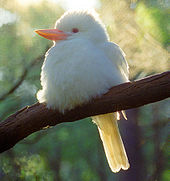
Conservation
All four kookaburra species remain listed as Least Concern, though habitat destruction remains of some concern.
In culture
Olly the Kookaburra was one of the three mascots chosen for the 2000 Summer Olympics in Sydney. The other mascots were Millie the Echidna and Syd the Platypus.
Although kookaburras are restricted to a relatively small part of the world, the distinctive sound of the Laughing Kookaburra makes has found its way onto many "jungle sound" soundtracks, used in filmmaking and television productions as well as certain Disney theme park attractions, no matter where in the world the action is set. They have also appeared in video games ( Lineage II, Battletoads, and World of Warcraft) and at least in one short story ( Barry Wood's Nowhere to Go).
In William Arden's 1969 book, The Mystery of the Laughing Shadow, (one of 'The Three Investigators' series for juvenile readers), the Laughing Kookaburra is an integral plot device.
The children's television series Splatalot! includes an Australian character called "Kookaburra" (or "Kook"). His costume includes decorative wings that recall the bird's plumage, and is noted for his distinctive high-pitched laugh.
Music
- A well-known children's song, Kookaburra
- Kookaburra, by Cocteau Twins, released on their EP Aikea-Guinea
- Kookaburra by John Vanderslice on 2007's Emerald City (album)
- The Kookaburras an English band from the County Durham.
- The lyric ...the Laughing Kookaburras call.. appears in the song Across the Hills of Home on the album Something of Value by Eric Bogle
BFD Records and BFD Productions, which are the distributors and/or copyright holders of most of the garage rock and psychedelic rock compilation albums in the Pebbles (series), are shown as having an address of Kookaburra, Australia.
Postage stamps
- A 6d (6 penny) stamp was issued in 1914.
- The 2nd commemorative Australian stamp to be issued was the 3d blue Kookaburra. The stamp was produce in sheets of four for the 1928 Melbourne International Philatelic Exhibition and was only the fourth miniature sheet to be manufactured anywhere in the world.
- A 38c Australian stamp was issued around 1990 and features a pair of kookaburras.
Coins
There has been an Australian coin known as the Silver Kookaburra minted annually since 1990.
Yacht
The Australian 12 metre yacht Kookaburra III unsuccessfully defended the America's Cup in 1987.
Hockey
The Australian Men's Hockey team is named after the Kookaburra. They are currently (as of 2010) world champions in the sport of field hockey.
